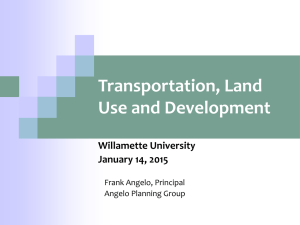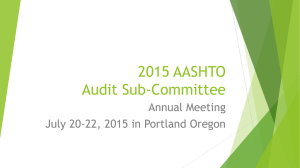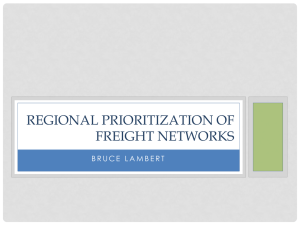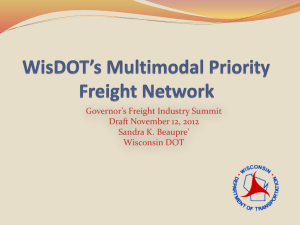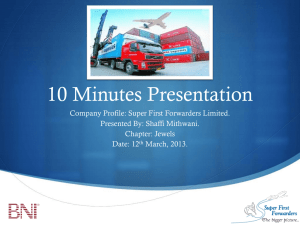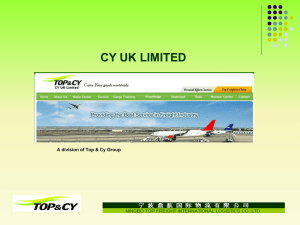Presentation - 15th TRB National Transportation Planning
advertisement
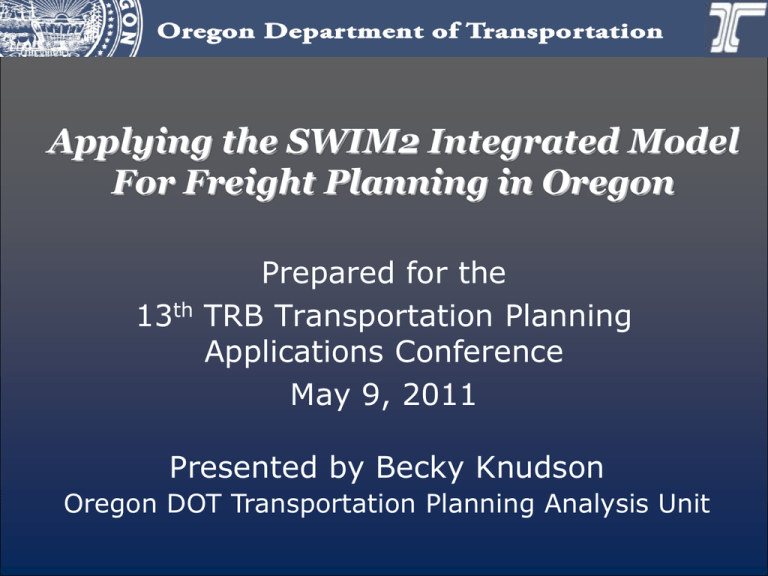
Applying the SWIM2 Integrated Model For Freight Planning in Oregon 13th Prepared for the TRB Transportation Planning Applications Conference May 9, 2011 Presented by Becky Knudson Oregon DOT Transportation Planning Analysis Unit Presentation Highlights • Describe Freight Plan analysis • Brief overview of the Statewide Integrated Model (SWIM2) • Key factors of effective modeling for long range planning • Contribution of analysis to planning process Description of Freight Plan Analysis Oregon Freight Plan • First statewide freight plan • Scope of analysis was well matched to SWIM2 model • ODOT modeling staff served role as internal consultants • Consultant staff served as extension of ODOT staff – Support of Freight Plan analysis – Continue model development Freight Plan Analysis Purpose • Forecast range of likely economic conditions to gain understanding of effects on freight movement – Illustrate variation in statewide and regional activity and commodity flows – Provide information to support development of freight strategies Analytical Approach • Plan for freight flows given an uncertain economic future • Use scenarios to evaluate range of possible futures Reference: “business-as-usual” (2.0%*) Optimistic: more economic growth (2.7%*) Pessimistic: less economic growth (1.2%*) High Transportation Costs: Pessimistic scenario with 3-fold increase in variable operating costs * Compound Annual Growth Rates Overview of Statewide Model Oregon StateWide Integrated Model (SWIM2) as Forecast Tool • SWIM is dynamic – integrates the dynamic interactions of land use, the economy and transportation infrastructure • SWIM1 used successfully on several statewide analyses – Proved its value repeatedly – Generated support for SWIM2 development • SWIM2 has greater spatial acuity – more detailed inputs and components – Can evaluate more policy options StateWide Integrated Model (SWIM2) SPATIAL Employment by Industry ECONOMY Construction$ Totals Production Totals Activity Logsums Space Prices Occupied Space Demand SYNTHETIC HH Labor ALLOCATION Space LAND Inventory DEVELOPMENT POPULATION Mode Choice Travel Time/Costs Logsums Labor Commodity Flows$ Flows$ (internal, import, export) TRANSPORT Travel Time/Costs Person Goods External OD Trip Tables ASSIGNMENT Aggregate/Equilibrium Micro-simulation Next Time Period Feedback StateWide Integrated Model (SWIM2) ECONOMY SPATIAL Employment Construction$ Economic Components by Industry Totals Production Totals Activity Logsums Space Prices Occupied Space Demand Spatially Represented SYNTHETIC HH Labor ALLOCATION Space LAND Inventory Population – Production/Consumption – Land Use DEVELOPMENT POPULATION Mode Choice Travel Time/Costs Logsums Labor Commodity Flows$ Flows$ (internal, import, export) TRANSPORT Travel Time/Costs Person Goods External OD Trip Tables ASSIGNMENT Aggregate/Equilibrium Micro-simulation Next Time Period Feedback StateWide Integrated Model (SWIM2) ECONOMY SPATIAL Employment Construction$ Economic Components by Industry Totals Production Totals Activity Logsums Space Prices Occupied Space Demand Spatially Represented SYNTHETIC HH Labor ALLOCATION Space LAND Inventory Population – Production/Consumption – Land Use DEVELOPMENT POPULATION Mode Choice Logsums Travel Time/Costs Labor Commodity Flows$ Flows$ (internal, import, export) TRANSPORT Transportation Components Person Goods External OD and Trip Tables WorkersTime/Costs –Travel Commodities Services (imports/exports, internal) ASSIGNMENT Traffic Assignment Aggregate/Equilibrium Micro-simulation Next Time Period Feedback Key Factors of Effective Modeling Analysis Effective Modeling for Long Range Planning • Myth: Sophistication of the modeling tool is the number one component of effective modeling Watson on Jeopardy Key Factors of Effective Modeling Analysis • Use models to inform and manage risk – The true value of modeling comes from how the analyst uses the tool, not the tool itself • Direct access to analyst – Answer questions immediately, alleviate misconceptions – Gain understanding of goals and objectives • Analyst must have good communication skills – Use good visuals – get-to-the-point - no jargon - relate findings to project goals Example: Use this… Group 7 Production and Consumption of Commodities by Non-Household Activities Group 8 Imports and Exports of Commodities ALD Space Development Group 2 Production of Labor by Households Group 3 Use of Space by Non-Household Activities Group 6 Consumption of Commodities and Labor by Households Group 9 Financial Flows Group 4 Use of Labor by Non-Household Activities Transport Demand and Supply Group 5 Use of Space by Households Even Better Use this… Stronger economy generates more commodity flow in terms of value Stronger economy generates more commodity flow in terms of tons 1) Query 2) Tables 3) Visuals SWIM VIZ Tool Contribution of Analysis to the Planning Process Contribution of Modeling Analysis to the Planning Process • Source of descriptive data used to frame discussion – Described economic conditions – Illustrated regional differences – revealed patterns of activity • Use model scenarios to address risk – facilitates planning despite many unknowns • Helped identify core issues • Reduced perception of bias Oregon ACT9 CascadesW ACT8 SW Variation by region… ACT7 Central ACT6 Lower JD ACT5 RV Pessimist ACT4 Scentral Reference Optimist ACT3 NE ACT2 Portland ACT12 Lane ACT11 SE ACT10 SW ACT1 NW 0.0% 1.0% 2.0% 3.0% 4.0% 5.0% 21Rate 2012-2027 All Industry Compound Average Growth 6.0% All Industries Retail, Personal Service, Communication Variation by industry sector… Paper, NonDurables Health Gov't, Education, Biz Services, Accommodations Pessimist Forestry, Wood Reference Electronics, Durables, Construction Optimist Ag, Mining, Food 0.0% 1.0% 2.0% 3.0% 4.0% 5.0% 6.0% 7.0% Statewide Compound Average Growth Rate 2012-2027 22 All Commodities PulpPaper Variation by commodity type… PetrolCoalChem OtherMisc MachineryInstTranspMetals Pessimist ForestorWood Reference Optimist FoodorKindredProducts ClayMineralStone -1.0% 0.0% 1.0% 2.0% 3.0% 4.0% 5.0% Statewide Commodity Production CAGR 2012-2027 23 6.0% 7.0% 8.0% Conclusions • Models are powerful tools – Effectiveness is determined by how they are used – Good sources of descriptive data – Good for evaluating “what if” scenarios, assessing risk • Using them for long range planning takes time and forethought • Planners and modelers must work together to realize the full potential of using these tools • The extra time used for analysis pays off in the end with a more productive outcome and smoother process Having our own Watson would be really, really cool For more information… Oregon Freight Plan: http://www.oregon.gov/ODOT/TD/FREIGHT/FREIGHT_PLAN.shtml Becky Knudson Oregon DOT, Planning Analysis Unit rebecca.a.knudson@odot.state.or.us Doug Hunt University of Calgary jdhunt@ucalgary.ca Alex Bettinardi Oregon DOT, Planning Analysis Alexander.o.bettinardi@odot.state.or.us Tara Weidner Parsons Brinckerhoff weidner@pbworld.com Erin Wardell Parsons Brinckerhoff wardell@pbworld.com
